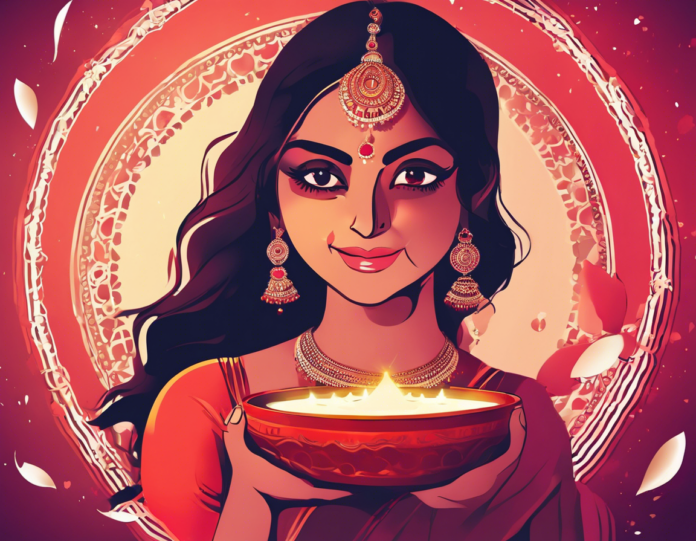Karwa Chauth is a traditional Hindu festival that holds a special place in the hearts of married couples in India. It is celebrated by married women who observe a day-long fast for the well-being and longevity of their husbands. The festival falls on the fourth day after the full moon in the Hindu month of Kartik, which is typically in October or November. This auspicious day is marked by rituals, prayers, and a strict fast that culminates with the sighting of the moon in the evening.
In this comprehensive guide, we will delve into the significance, traditions, rituals, preparations, and celebrations of Karwa Chauth, providing you with all the information you need to observe this festival with reverence and joy.
Significance of Karwa Chauth
Karwa Chauth is steeped in tradition and symbolism, embodying the deep bond between a husband and wife. The word "Karwa" refers to an earthen pot used during the rituals, while "Chauth" means the fourth day. The fast observed by married women on this day is believed to ensure the well-being, prosperity, and longevity of their husbands. It is also seen as a day to celebrate the institution of marriage and strengthen the marital bond.
Traditions and Rituals
Fasting
The most significant aspect of Karwa Chauth is the day-long fast observed by married women. They abstain from food and water from sunrise until they sight the moon in the evening. The fast is broken after offering prayers and performing the rituals associated with the festival.
Sargi
Sargi is a pre-dawn meal that is consumed by women who are observing the fast. It is given by the mother-in-law and typically includes fruits, sweets, and other delicacies. Sargi is meant to sustain the women throughout the day while they fast.
Puja and Katha
In the evening, women gather together for the puja, which involves worshipping Lord Shiva, Goddess Parvati, and the Moon God. A Karwa Chauth vrat Katha, or story, is recited to narrate the significance of the festival and inspire the women to observe the fast with devotion.
Moon Sighting
The fast is only broken after the moon is sighted in the evening. The woman looks at the moon through a sieve and then at her husband, after which he helps her break the fast by offering her water and the first morsel of food.
Preparations for Karwa Chauth
Shopping
Women begin preparations for Karwa Chauth days in advance, shopping for new clothes, jewelry, and puja items. Red is considered an auspicious color for this festival, so women often choose to wear red outfits.
Mehendi
Applying mehendi or henna on the hands is an essential part of Karwa Chauth celebrations. Intricate designs are drawn on the hands and feet of married women, adding to the festive spirit of the occasion.
Puja Thali
A beautifully decorated puja thali with items like a Karwa (earthen pot), diya (lamp), chandan (sandalwood paste), kumkum (vermilion), and sweets is prepared for the evening rituals. This thali plays a central role in the puja ceremony.
Fasting Essentials
Women ensure they have all the essential items for the fast, such as fruits, water, and the sargi from their mother-in-law. It is important to have everything ready before sunrise to begin the fast.
Celebrations of Karwa Chauth
Dressing Up
Women dress up in traditional attire, usually in red or other vibrant colors, on the day of Karwa Chauth. They adorn themselves with jewelry, apply mehendi, and take special care in their appearance for the festival.
Community Gatherings
Karwa Chauth is a time for women to come together and celebrate. Many communities organize gatherings or events where women can participate in the rituals, share stories, and enjoy each other's company.
Romantic Gestures
Husbands often shower their wives with love and affection on Karwa Chauth. They may offer gifts, pamper them with special treats, or even fast along with their wives as a gesture of solidarity and support.
Festive Mood
The joyous atmosphere on Karwa Chauth is palpable, with markets bustling with shoppers, streets adorned with decorations, and the air filled with excitement and anticipation. It is a time of revelry and togetherness for married couples.
FAQs (Frequently Asked Questions)
1. What is the origin of Karwa Chauth?
Karwa Chauth has its roots in Hindu mythology and is believed to have originated as a way for wives to pray for the safety of their husbands who went off to war.
2. Can unmarried women observe Karwa Chauth?
While Karwa Chauth is traditionally observed by married women, unmarried women, too, can observe the fast for the well-being of their future spouses or to seek a loving and devoted partner.
3. Are there any exemptions from fasting on Karwa Chauth?
Pregnant women, nursing mothers, the elderly, or those who are unwell are exempted from fasting on Karwa Chauth. They can opt for a partial fast with fruits and milk.
4. What is the significance of looking at the moon through a sieve during Karwa Chauth?
It is believed that looking at the moon through a sieve and then at the husband removes any obstacles or negative influences that may affect the marital bond, ensuring a long and prosperous married life.
5. How can one make Karwa Chauth celebrations special?
To make Karwa Chauth celebrations special, couples can plan romantic gestures, exchange thoughtful gifts, spend quality time together, and partake in the rituals and festivities with love and devotion.
Karwa Chauth is more than just a festival; it is a celebration of love, commitment, and togetherness. The rituals and traditions associated with this auspicious day symbolize the deep bond between a husband and wife and the extent to which they are willing to go for each other's well-being. By observing Karwa Chauth with devotion and joy, couples strengthen their relationship and create lasting memories that they will cherish for years to come.

